Experience Sharing
Central Conveying Applied in Home Appliance Field
As living standard increasing, more and more home appliances have entered ordinary people’s home and been an important part of family. The home appliances became inseparable in people’s daily life. Nowadays, there are countless types of home appliances on market, products in the same field have varies of different kinds.
In current of the internet + age, people‘s purchase capability of commodity has increased several times than before. The price of merchandise is getting more and more transparent, thereby the price war gets as one falls another rises. Especially in home appliance industry, the competition comes to white hot stage. Therefore, at the same time of sales growing, how to lower costs and shorten production cycle is one of the key factors.
One Group Share Limited Company founded in 1981 at Hefei is a large listed enterprise which mainly engaged in home appliance, information, communication, electrical product R & D, production and sales. Shini devoted its strength and planned a system covered 2 workshops for this company, which are refrigerator and washing machine workshop. The refrigerator workshop contains injection molding area and squeeze plate area for refrigerator.
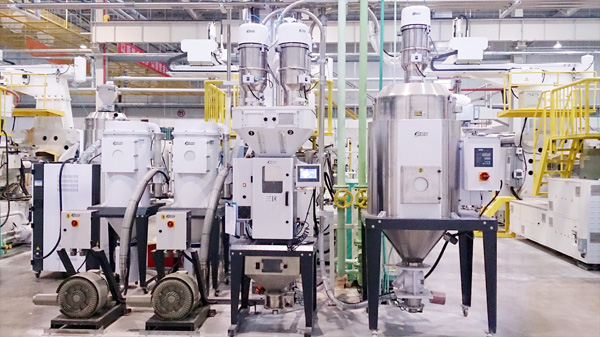
Injection molding area of refrigerator adopts unified central conveying method, according to machine usage and by distributor free switching to complete material conveying from the dryer to injection molding machine. In the initial planning, considering the circumstance that the height limit of material storage area and its large usage amount, the burying way of storage tank is adopted. By the hauling-up device for material feeding, it largely lowers human manipulation strength, improves working efficiency and reduces the worker for feeding. The system also used some masterbatches, in order to reduce the workload of worker in injection molding workshop, avoid masterbatch dosing mistake, purify workshop environment, central conveying method is applied. All material feeding of this high-degree automatic system are located in material storage area for convenient unified management.
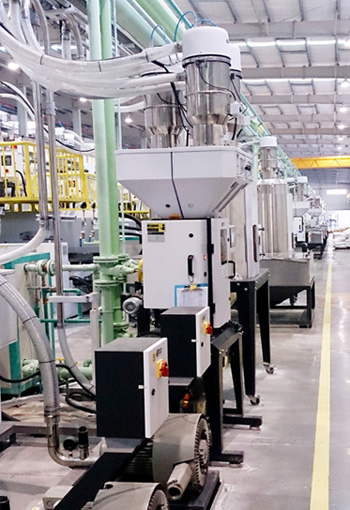
There is large material usage in refrigerator’s squeeze plate area, the amount is above ten tons everyday. If uses manual pouring method for materials, it’s unrealistic. So positive pressure conveying is employed. Use forklift to put the material into temporary storage, then convey the material into storage silo in one time, it not only saves time but also saves trouble, saves labor as well. In the process of refrigerator plate production, it needs the gravimetric blender to mix the three materials proportionally for the machine which ensures excellent production quality.
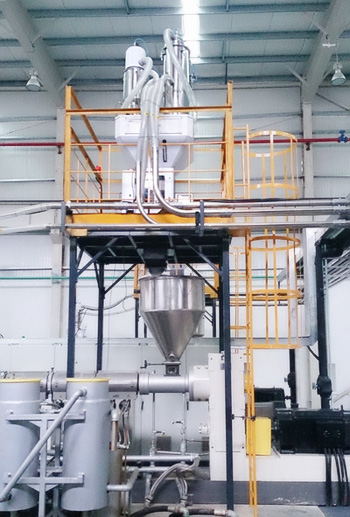
Washing machine workshop divided into areas and adopts central conveying design. It has 7 conveying areas. As material feeding is in desperation state, and machine between in large distance, if only takes the central conveying method, it is not scientific and would waste lots of pipe accessories, which loses the advantages of central conveying. The 7 conveying areas all equipped with gravimetric blenders and need to process the proportional mixing for material and masterbatch, then convey the mixture to the dryer for drying, therefore, it ensures the product’s molding quality. The IMM also equipped with mixer and machine-mount dryer which possess the function as second mixing and drying. It prevents delamination of material and masterbatch, prevents moisture regain that may influence product quality. At the same time, each area equipped with independent air pump for no mutual impact and ensuring system stability.
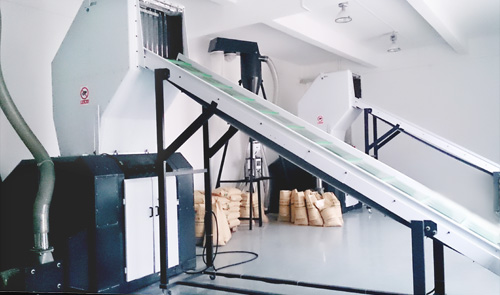
It was inevitable to have rejects and sprue in the production, so the system was considered to use central granulating method. The crushed granules centrally conveyed to the material appointed storage hopper.
In the process, it only needs worker to put the rejects or sprue on the conveyor, and wait till them fall into the granulator, other steps are all finished by automatic conveying completely.
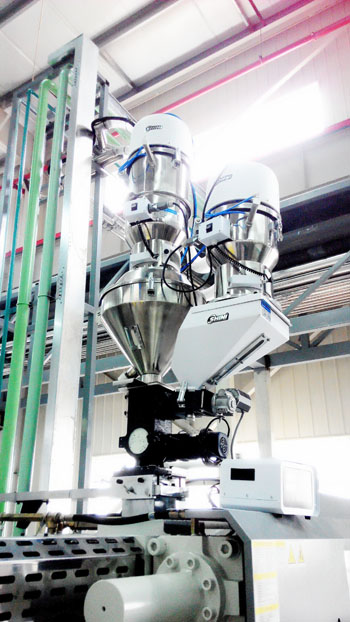
From initial design till the installation and debugging of the system, it takes almost one year. During the process, the scheme experienced several times of review and revision, which finally put into operation successfully under the joint efforts of all of us. Now, the system operates stably, it saves huge costs for the customer, improves production efficiency and obtains customer’s recognition.
Experience Sharing
- Robot for thin-wall product in Food packaging features
- Application of Shini Central Conveying System
- Shini Gravimetric Blender SGB Successfully Applied in Artificial Turf Industry
- Application of Shini sLink Protocol Solution in Injection Molding System
If you want to read other articles, back to2015 Quarter 4 Issue 25.
